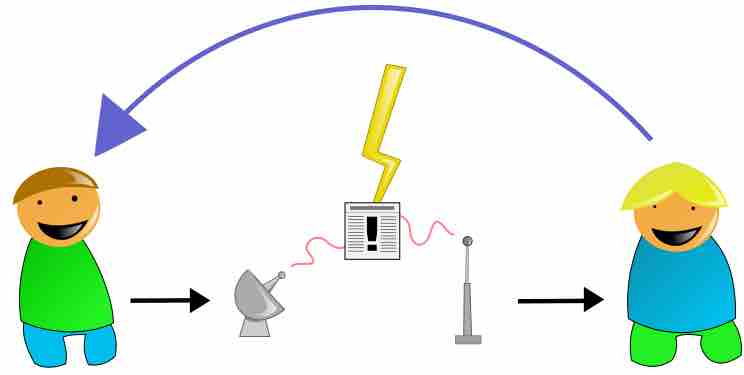The Communicative Process
Mathematicians Claude Shannon and Warren Weaver defined communication as comprising the following five general components:
- An information source (i.e., sender). This produces a message; in an oral conversation, the information source is simply the speaker.
- A transmitter. This encodes the message into signals.
- A channel. Signals are adapted to this channel for transmission.
- A receiver. This "decodes" (i.e., reconstructs) the message from the received signals.
- A destination. This is where the message arrives; in an oral conversation, the destination is simply the listener.

Shannon-Weaver model of communication
This diagram shows the five steps of the communicative process identified by Shannon and Weaver.
Distractions—i.e., noise—can disrupt the flow of information between any of these five stages. That is to say, issues in communication pertaining to distraction could affect the sender, the message itself, the channel it is being sent through, or the recipient of that message.
Communicative Interference
Every organization faces certain barriers to communication. Shannon and Weaver argue there are three particular layers of communication problems:
- Technical: How accurately can the message be transmitted?
- Semantic: How precisely can the meaning be conveyed?
- Efficacy-related: How effectively does the received meaning affect behavior?
These layers relate to a variety of types of noise that can interfere with communication.
Environmental Noise
Environmental noise is noise that physically disrupts communication, such as very loud speakers at a party or the sounds from a construction site next to a classroom.
Physiological-Impairment Noise
Physical conditions such as deafness or blindness can impede effective communication and interfere with messages being clearly and accurately received.
Semantic Noise
Semantic noise refers to when a speaker and a listener have different interpretations of the meanings of certain words. For example, the word "weed" can be interpreted as an undesirable plant in a yard or as a euphemism for marijuana.
Syntactical Noise
Communication can be disrupted by mistakes in grammar, such as an abrupt change in verb tense during a sentence.
Organizational Noise
Poorly structured messages can also be a barrier. For example, a receiver who is given unclear, badly worded directions may be unable to figure out how to reach their destination.
Cultural Noise
Making stereotypical assumptions, such as unwittingly offending a non-Christian person by wishing them a "Merry Christmas," can also detract from communication. Because of this, it is important that each side of a conversation understands the culture of the other party.
Psychological Noise
Certain attitudes can also make communication difficult. For instance, significant anger or sadness may cause someone to lose focus on the present moment.
By acknowledging and adjusting to noise, a communicator can make it more likely that their message will be received as intended.